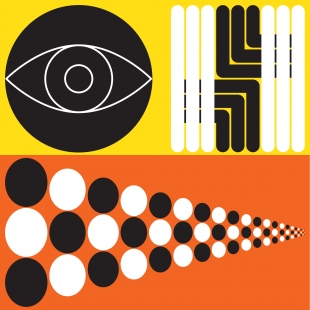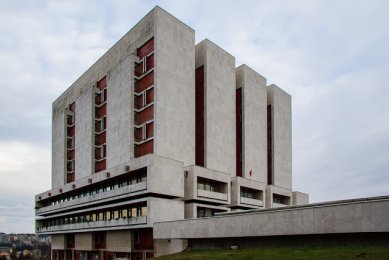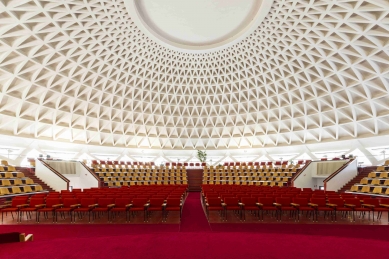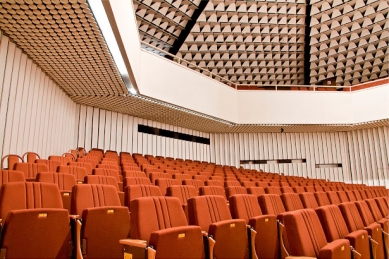
Monika Mitášová: Architect Vladimír Dedeček
Source
PRAHA/Fórum pro architekturu a média
PRAHA/Fórum pro architekturu a média
Publisher
Tisková zpráva
29.01.2016 09:45
Tisková zpráva
29.01.2016 09:45
Vladimír Dedeček
On Friday, January 29, 2016, from 7:00 PM, at PRAHA / Forum for Architecture and Media on Husova Street 18a in Brno, there will be a lecture by Monika Mitášová Architect Vladimir Dedeček. The lecture is part of the accompanying program for the project Architecture is here! Vladimir Dedecek: Práca.
Assoc. prof. ing. arch. Monika Mitášová, Ph.D. studied architecture at the Faculty of Architecture SVŠT in Bratislava and focuses on the history of theories and contemporary theories of architecture. She worked at the Center for Theoretical Studies UK and the Academy of Sciences of the Czech Republic in Prague, currently lectures in Trnava, previously at the School of Architecture AVU in Prague and at FA TU in Liberec. Among other things, she is the editor of two books of texts and interviews on American critical and projective architecture, Oxymoron and pleonasm I-II, and together with Jiří Ševčík compiled the anthology Czech and Slovak Architecture 1971-2011. She has served as a curator of the architecture collection at SNG and is currently preparing an exhibition about architect Vladimir Dedeček. She will also focus on his work in her lecture.
Vladimir Dedeček has created more than ninety architectural realizations and designs during his nearly half-century career – from family houses to extensive university complexes or cultural institutions, revealing the resilience of his nature, as well as a clear and consistent approach to design. The "Dedeček style" is characterized by an emphasis on rhythm and a sculptural plasticity that never exceeded the clarity of basic geometric shapes – he always remained true to the modern concept.
In 2007, Austrian photographer Hertha Hurnaus published the book Eastmodern - Architecture and Design of the 1960s and 1970s in Slovakia. It is paradoxical that a foreign publication could spark interest in post-war architecture here as well. Do you think that was the case, or was there already interest earlier?
Hertha's impulse was crucial for further foreign responses, which were initiated before her by architects Greg Lynn, Peter Cook, Wolf Prix, Jan Neutellings, NL Architects, and Domink Parrault, who lectured at SNG and the VŠVU in Bratislava. In Slovakia, there had long been several other groups of people interested in Dedeček's architecture by the time her book was published. In 2001, the Slovak National Gallery (SNG) held a public discussion about the closure of Dedeček's southern wing, which was in a state of disrepair, regarding its possible reconstruction, in which architectural historian Štefan Šlachta spoke in favor of demolishing Dedeček's wing, the so-called bridge. Thus, there was a heated public debate that ended with a petition from many members of the Slovak Architects' Association to preserve the bridge. SNG announced two architectural competitions. Professors Imro Vaško and Marián Zervan, along with colleagues and students at the Department of Architectural Design at VŠVU in Bratislava, were already then collaborating on the project Parallel Modernism and were among the first to address the work of Vladimir Dedeček. Jan Tabor from Vienna also contributed significantly to this. And architecture historian Dana Bořutová assigned – then art history student – Peter Szalay at Comenius University in Bratislava a thesis on Dedeček's work, which he defended in 2005. Since then, his interest in this topic has dated. Thus, the debate about Dedeček in Slovakia was initiated by architects and art scholars, SNG, and the academic environment. Hertha Hurnaus brought remarkable contributions to the debate, which were perceived at that time by Dedeček’s opponents in Slovakia as an intervention by a handful of leftist Viennese intellectuals and Bratislava's "golden youth".
Currently, you are preparing a monograph on Vladimir Dedeček and are collaborating with Hertha Hurnaus. Can you tell us more about the book? When can we expect its publication?
The idea to publish a book about architect Dedeček was born at SNG in 2009. Hertha Hurnaus accepted participation in its preparation at that time. Over the next seven years, she gradually photographed the architect’s groundbreaking buildings. The book was created based on interviews with the architect, archival research, study, and interpretation of his buildings and their architectural documentation. Its final form was achieved in 2014-2015, and SNG will publish it sometime this spring as two “booklets”: a small and a larger one. After all, architect Dedeček is alive, and many period documents from Bratislava's Stavoprojekt are not yet accessible to researchers, if they ever become accessible. These two booklets thus rather open a discussion about the interpretation of architecture than canonize a privileged or despised image of Dedeček's work.
You served as a curator at the Slovak National Gallery, and the gallery is also the publisher of the forthcoming monograph. Can we expect an exhibition project along with the book?
I co-organized a small exhibition and a series of lectures in July 2009 at SNG on the occasion of architect Vladimir Dedeček's 80th birthday. The architecture studio of Benjamin Brádňanský and Vítem Haladou, in collaboration with the Department of Photography at VŠVU, Filip Vanč’s photography studio, and in cooperation with photographer Illa van Oijen, prepared a temporary installation of architectural analyses and photographic interpretations of his work in the SNG bridge at that time. Last week, the reconstruction of the SNG premises began, which should be completed in 2018. Until then, Dedeček's exhibition will certainly not be there. Finally, the traveling exhibition of his work, prepared by a group around historian Peter Szalay, has once again reminded us of him. It seems that Dedeček's architecture always rises from the ashes in some new form…
The interview was prepared for 4AM/Forum for Architecture and Media by Barbora Benčíková and Šárka Svobodová.
More information >
Assoc. prof. ing. arch. Monika Mitášová, Ph.D. studied architecture at the Faculty of Architecture SVŠT in Bratislava and focuses on the history of theories and contemporary theories of architecture. She worked at the Center for Theoretical Studies UK and the Academy of Sciences of the Czech Republic in Prague, currently lectures in Trnava, previously at the School of Architecture AVU in Prague and at FA TU in Liberec. Among other things, she is the editor of two books of texts and interviews on American critical and projective architecture, Oxymoron and pleonasm I-II, and together with Jiří Ševčík compiled the anthology Czech and Slovak Architecture 1971-2011. She has served as a curator of the architecture collection at SNG and is currently preparing an exhibition about architect Vladimir Dedeček. She will also focus on his work in her lecture.
Vladimir Dedeček has created more than ninety architectural realizations and designs during his nearly half-century career – from family houses to extensive university complexes or cultural institutions, revealing the resilience of his nature, as well as a clear and consistent approach to design. The "Dedeček style" is characterized by an emphasis on rhythm and a sculptural plasticity that never exceeded the clarity of basic geometric shapes – he always remained true to the modern concept.
In 2007, Austrian photographer Hertha Hurnaus published the book Eastmodern - Architecture and Design of the 1960s and 1970s in Slovakia. It is paradoxical that a foreign publication could spark interest in post-war architecture here as well. Do you think that was the case, or was there already interest earlier?
Hertha's impulse was crucial for further foreign responses, which were initiated before her by architects Greg Lynn, Peter Cook, Wolf Prix, Jan Neutellings, NL Architects, and Domink Parrault, who lectured at SNG and the VŠVU in Bratislava. In Slovakia, there had long been several other groups of people interested in Dedeček's architecture by the time her book was published. In 2001, the Slovak National Gallery (SNG) held a public discussion about the closure of Dedeček's southern wing, which was in a state of disrepair, regarding its possible reconstruction, in which architectural historian Štefan Šlachta spoke in favor of demolishing Dedeček's wing, the so-called bridge. Thus, there was a heated public debate that ended with a petition from many members of the Slovak Architects' Association to preserve the bridge. SNG announced two architectural competitions. Professors Imro Vaško and Marián Zervan, along with colleagues and students at the Department of Architectural Design at VŠVU in Bratislava, were already then collaborating on the project Parallel Modernism and were among the first to address the work of Vladimir Dedeček. Jan Tabor from Vienna also contributed significantly to this. And architecture historian Dana Bořutová assigned – then art history student – Peter Szalay at Comenius University in Bratislava a thesis on Dedeček's work, which he defended in 2005. Since then, his interest in this topic has dated. Thus, the debate about Dedeček in Slovakia was initiated by architects and art scholars, SNG, and the academic environment. Hertha Hurnaus brought remarkable contributions to the debate, which were perceived at that time by Dedeček’s opponents in Slovakia as an intervention by a handful of leftist Viennese intellectuals and Bratislava's "golden youth".
Currently, you are preparing a monograph on Vladimir Dedeček and are collaborating with Hertha Hurnaus. Can you tell us more about the book? When can we expect its publication?
The idea to publish a book about architect Dedeček was born at SNG in 2009. Hertha Hurnaus accepted participation in its preparation at that time. Over the next seven years, she gradually photographed the architect’s groundbreaking buildings. The book was created based on interviews with the architect, archival research, study, and interpretation of his buildings and their architectural documentation. Its final form was achieved in 2014-2015, and SNG will publish it sometime this spring as two “booklets”: a small and a larger one. After all, architect Dedeček is alive, and many period documents from Bratislava's Stavoprojekt are not yet accessible to researchers, if they ever become accessible. These two booklets thus rather open a discussion about the interpretation of architecture than canonize a privileged or despised image of Dedeček's work.
You served as a curator at the Slovak National Gallery, and the gallery is also the publisher of the forthcoming monograph. Can we expect an exhibition project along with the book?
I co-organized a small exhibition and a series of lectures in July 2009 at SNG on the occasion of architect Vladimir Dedeček's 80th birthday. The architecture studio of Benjamin Brádňanský and Vítem Haladou, in collaboration with the Department of Photography at VŠVU, Filip Vanč’s photography studio, and in cooperation with photographer Illa van Oijen, prepared a temporary installation of architectural analyses and photographic interpretations of his work in the SNG bridge at that time. Last week, the reconstruction of the SNG premises began, which should be completed in 2018. Until then, Dedeček's exhibition will certainly not be there. Finally, the traveling exhibition of his work, prepared by a group around historian Peter Szalay, has once again reminded us of him. It seems that Dedeček's architecture always rises from the ashes in some new form…
The interview was prepared for 4AM/Forum for Architecture and Media by Barbora Benčíková and Šárka Svobodová.
More information >
The English translation is powered by AI tool. Switch to Czech to view the original text source.




0 comments
add comment
Related articles
0
07.10.2024 | Architect Dedeček – opening in SNG
0
30.09.2024 | Architect Dedeček - exhibition at SNG
0
20.02.2019 | Inaugural lectures by Petr Vorlík and Monika Mitášová at FA CTU
0
18.12.2017 | Monika Mitášová and Marián Zervan: Vladimír Dedeček
0
02.11.2017 | Monika Mitášová and Marián Zervan: Vladimír Dedeček
0
27.10.2017 | Monika Mitášová and Marián Zervan: Vladimír Dedeček
0
30.03.2016 | Monika Mitášová: Eisenman's interpretation of Terragni
0
04.12.2015 | Vladímír Dedeček: Work - Invitation to Film Screening
0
03.04.2015 | Ostrava Lecture by Architecture Theorist Monika Mitášová
1
30.10.2009 | Vladimír Dedeček's lecture in the autumn cycle Matadors/Matarokas












